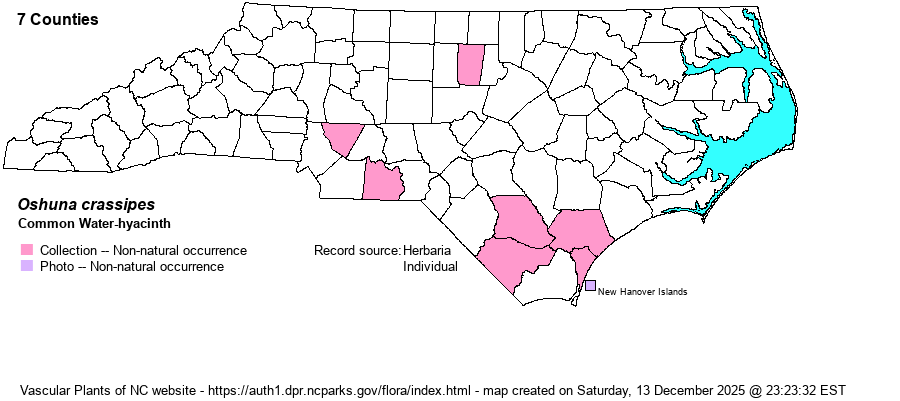| Author | (Martius) A. Haines | |
| Distribution | Mostly southern Coastal Plain; also a few Piedmont counties. First collected in NC in 1949 at a pool in Polkton, Anson County, by Radford.
Native of the Neotropics; in N.A. well established in the Southeastern states, particularly troublesome in states farther to the south of NC. | |
| Abundance | Rare. It is not known if any NC populations are self-sustaining or reproducing (data lacking on labels), but they do overwinter successfully. At least some, perhaps most, NC occurrences may have been started by discarded aquarium plants or aquatic garden plants. This species should be monitored and eradicated locally where it is invasive, as Weakley (2024) quotes another person in 1987 saying it is "generally considered the world's most serious aquatic weed". | |
| Habitat | Artificial ponds, farm pond, "swampy slough near Northeast Cape Fear River", roadside wetland, "Middle Battle Park" (Orange County). | |
| Phenology | Flowering and fruiting June-September. | |
| Identification | This species is easily identified vegetatively by the rotund leaf blades whose stems are usually inflated. The large and fleshy leaves form a floating rosette, from which a conspicuous stalk of pale blue or lavender flowers grow, each with a yellow central spot. The species typically occurs in very dense stands such that it is difficult for a boat to move through it. | |
| Taxonomic Comments | Weakley (2020) transferred it from Eichhornia crassipes to Piaropus crassipes. However, in his 2022 floras, he follows Haines, who said that the former Piaropus genus name is invalid and who coined a new genus name of Oshuna.
| |
| Other Common Name(s) | | |
| State Rank | SE | |
| Global Rank | G5 | |
| State Status | | |
| US Status | | |
| USACE-agcp | | |
| USACE-emp | | |

